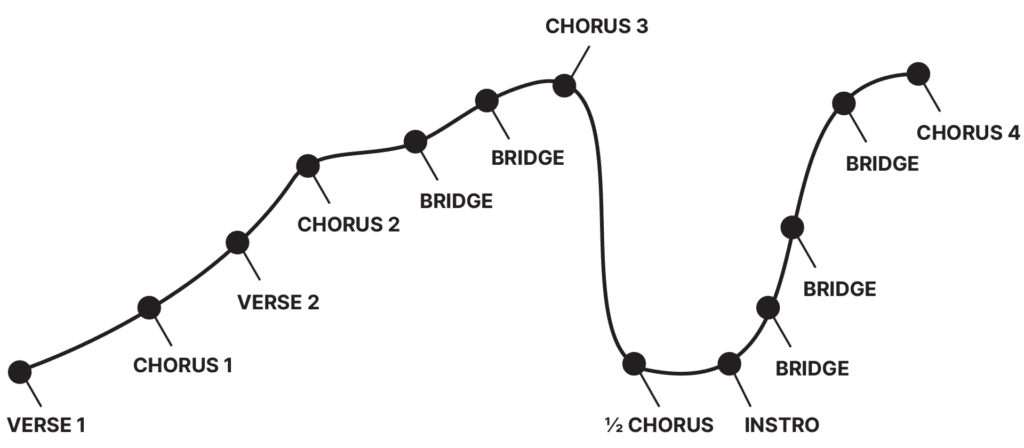How to Add Dynamics to Your Worship Songs
- By Charmaine Brown
- 9 Comments
Growing up, I loved theme parks… especially the big ones with so many different types of rollercoasters. The upside-down ones. The stand-up ones. The lying-down ones (technically called “bobsled coasters”… who knew?!). The floorless ones.
The best part? The element of surprise. Even when you KNOW the big drop is coming, or you’re about to go upside down, or it’s suddenly going to accelerate… STILL… it’s exciting every time!
Now… imagine a rollercoaster that stays at the same speed and the same elevation for the entire ride. (Give this coaster a name in the comments!)
Can someone say… boring?! (Or in some cases… sickening!)
Doesn’t sound particularly appealing, does it? But when we sing a song without dynamics, that’s exactly what happens. The appeal is lost.
What are dynamics?
The dictionary defines “dynamics” as: “variation and contrast in force or intensity”; another definition says: “variation and graduation in the volume of musical sound”.
In our worship leading, to add dynamics means that we intentionally play with the intensity of how we’re singing a song in order to create movement, emotion and interest.
Easier said than done though!
So many singers tend to sing at one volume the whole song (this was me for YEARS when I started worship leading).
Sometimes it’s just plain LOUD.
The volume knob is turned all the way up… all the time. (If you’ve been told to “back off the mic” over and over, this might be you!)
It’s a rollercoaster that does NOTHING but fast, high, constant loop-the-loops over and over for 5 minutes… then slows down slightly… only to start again for 5 minutes. And then again. (aka your Sunday set list)
It’s powerful. It’s passionate. But it’s… too much. Especially after eating a funnel cake.
Other vocalists tend to sing quietly and breathy.
The volume knob is turned all the way down… all the time. (If you’ve been told to “eat the mic” over and over, this might be you!)
It’s the kiddie coaster that does NOTHING but slow and low for 5 minutes… then comes to a stop and starts over… slow and low for another 5 minutes. And then again. (aka your Sunday set list)
It’s gentle. It’s nice. But it’s… too little. You wish you had a funnel cake to enjoy while on the ride.
Other vocalists stay at kind of a mid-level volume that doesn’t ever change—and so we never get the soft, intimate moments OR the powerful, passionate, big moments.
Fill in the blank with an imaginary rollercoaster that you don’t want to wait in line for. Get a funnel cake instead.
In any and all of these cases… what happens when we don’t use dynamics is that the song (and your voice) ends up sounding very one-dimensional, which is not very engaging for our congregations to sing along with.
When there’s no change in the intensity of the sound, it’s actually tiring—and eventually agitating—for the listener’s ear.
This has been proven scientifically… that our ears need (and crave!) changes in frequency when we’re listening to something… they need movement—so as worship leaders and worship team singers, we have a responsibility to use dynamics in our voice and our songs in order to create an environment that’s easy and inviting for people to join in and sing along!
And not only that, but it’s tiring for your voice to always sing at the same volume! Our vocals cords also crave change, movement and rest—they need these things in order to stay healthy!
So to sum up…
SINGING WITHOUT DYNAMICS
- is one-dimensional
- is tiring for your voice
- is agitating to the listener’s ear
SINGING WITH DYNAMICS
- promotes health in your voice
- creates movement, emotion & interest in a song
- is interesting for the listener
- creates an engaging environment for people to join in and sing along
So… we know we need to add dynamics. But how do we go about doing that… practically?
I got you!
Here are 8 ways you can add dynamics to your songs:
#1 // Change the volume when heading into a new section of a song.
The most basic kind of dynamics is to have at least a subtle change in volume and intensity when you hit a new section of a song (ex. going from verse to chorus, chorus to verse 2, chorus into bridge, bridge back into the chorus, etc.)—basically anytime you’re headed into a new section of the song. The volume of our song can’t just be one straight line—there needs to be an ebb and flow of volume and intensity changes throughout a song.
#2 // Start softly to allow room to grow.
At the beginning of a song, a general rule of thumb is to start by singing softly in order to allow room for the song to grow. We can’t just start every song like a bulldozer—no!—we want to ease people in and say “please come on this journey with me”... not “GET OVER HERE”!
#3 // Play with tone and textured qualities.
Another thing that adds dynamics is a change in tonal quality from section to section. For example, moving from a breathy, textured sound in the verse to a clear tone in the chorus (or vice versa—from clear to textured!) creates a really nice dynamic shift—you may not even necessarily be singing much louder in the chorus, but the shift into a clear tone communicates a shift in intensity. By leaning into the lyric just that little bit, we end up achieving a beautiful dynamic change!
I teach these stylistic techniques in-depth in my Master Your Voice course, in particular in the “Playing with Tone” and “Playing with Texture” lessons, so make sure to check those out!
#4 // Change the intensity when repeating a song section.
If you have a repeating section of a song (many times the bridge of a worship song repeats the same melody and/or lyrics over and over), that’s often a good place to plan for a steady increase in intensity. The important thing is to not start too loud at the beginning of a bridge—otherwise you don’t leave yourself enough room to grow (I’ve done that many times before… I start the bridge out too loud and then I end up pushing and yelling to try to raise the intensity!).
#5 // Jump the octave.
Another thing that can add so much dynamic to a repeating song section is an octave jump! It really takes things to another level when we suddenly shift from singing low and move into a big, powerful mix voice tone up high—because there’s so much more natural brightness in the tone quality up in the higher range! (Jumping down the octave can also create a powerful—but different—effect!)
#6 // Communicate with the musicians.
This is an important one! Instrumentally, dynamics need to be happening as well. If you’re singing quietly and the band is playing at full blast, or if you’re going all-out in a powerful moment and the band is playing quietly, it’s not going to create the dynamics you were aiming for… so if you’re the leader, don’t just leave it up to “whatever” everybody happens to play—it’s important to work with your band very closely and intentionally to communicate the dynamics that you’re wanting to achieve!
#7 // Be intentional with harmonies.
If you do sing in a worship team context, being intentional with adding harmony is a huge way to add dynamics. I go into this in-depth in some of my harmony training videos—in particular, the “Role of a Background Vocalist”, “Achieving Vocal Blend”, and “When to Sing Harmony” videos, so make sure to check those out, as well as my course called “Learn to Sing Worship Harmony”
The basic principle is that we create dynamics by adding something that wasn’t there, or by taking away something that was there.
Think about this in the context of harmony. If you have every vocalist singing—melody and multiple harmonies, or even just one harmony—right from the beginning of the song, you’re not leaving room for a change in intensity. But—if you start out with the lead melody solo’d, and then add and remove harmonies intentionally all throughout the song, it creates an incredible dynamic journey!
#8 // Create subtle volume changes throughout the melodic phrases.
The most advanced type of dynamics is to aim for a slight shift in intensity and volume throughout each phrase. When we can create subtle volume changes throughout our phrases (or even just on one note!), it takes a song to a whole new level! If you ever took piano lessons, you’re probably familiar with the terms “crescendo” (which means a “gradual increase in loudness”) and “decrescendo” (which means a “gradual decrease in loudness”)—that’s exactly what we need in our worship songs!


LISTENING EXERCISE
The song ”Who You Say I Am” (from the Hillsong Worship “There is More” album) is a great example of dynamics in action—take a listen and check out my observations of how they incorporated dynamics in so many different ways!
✔️ Change the volume when heading into a new section of a song.
- continual building and release of vocal intensity (worship leader and supporting vocalists) as song moves from section to section (esp verse 1 → chorus, chorus → verse 2, later chorus → soft chorus repeat, later bridge → bridge repeat etc.)
- male solo in later part of song before it builds big and adds lead vocalist and harmonies back in
✔️ Start softly to allow room to grow.
- song starts softly (still energy in the voice and instruments, but more subdued!)
- starts as solo vocal, then adds harmonies as song builds
✔️ Play with tone and textured qualities.
- shift from slightly textured sound in verse to more pharyngeal mix tone in chorus
- shift into softer/more textured vocal quality halfway through song when instruments drop out (“in my Father’s house”)
✔️ Change the volume/intensity when repeating a song section.
- intensity jump as bridge repeats (later in the song)
- shift into softer/more textured vocal quality halfway through song when instruments drop out (“in my Father’s house”)
✔️ Jump the octave.
- octave jump at end of second verse (“yes He died for me”)
✔️ Communicate with the musicians.
- instruments and voices build and drop in the same moments throughout song
✔️ Be intentional with harmonies.
- starts as solo vocal, then adds harmonies as song builds (first chorus)
- male solo in later part of song before it builds big and adds lead vocalist and harmonies back in
✔️ Create subtle volume changes throughout the melodic phrases.
- slight volume changes throughout melodic phrases (esp. in verses — ex “but He brought me in”, “ransomed me”, chorus — “there’s a place for me”, “yes I am”)
So… back to thinking about rollercoasters. 😄
Non-stop high intensity = too much.
Too much for the listeners’ ears and too much for your voice. (For real—singing at high intensity all the time is a solid path to vocal damage… the vocal cords don’t tend to handle this well!)
Non-stop low/mid intensity = too little.
Too little for your voice (you won’t grow your power and range by singing this way!) and too little to keep people engaged (lack of dynamics leads to lacklustre engagement).
We want our songs to be interesting and engaging, and for our voices to have longevity and health!
Singing with dynamics will go a LONG way to achieving these things.
But please, please… give yourself grace as you learn dynamics! It’s ok to start simple and one-dimensional as you’re learning to sing (or learning to ride rollercoasters), but staying there forever speaks to a lack of vocal and worship leading maturity.
BUT… when we’re intentional with our dynamics, instead of the song sounding one-dimensional, it will sound incredible!
Using dynamics adds so much dimension—because what it creates is a build-up and release of tension… over and over, and that beautiful tension is part of what makes music so interesting and emotional… and why we keep listening!
It’s the difference between this…

And this…

Look familiar?

It’s the rollercoaster for the mature. For the wise.
It’s the rollercoaster that you want to stand in line for because… it’s exciting! It’s got the slow. The fast. The quiet. The loud. The loop-the-loop (if you like that kinda thing).
So—what ways are YOU going to add dynamics to your songs next Sunday?
Tell me how it goes when you try out these techniques in your songs! And don’t forget—help me name that boring one-dimensional coaster in the comments!

Responses
Wooow! Interesting. I will put to practice. Thanks alot
You’re welcome! Glad you enjoyed it!
Great pointers, Thanks!
What do you think about bringing the music to just down to the keyboard just to slow things down and gradually build up, key changes after a chorus to a new verse, during the chorus, drum solo for chorus or bridge etc.
Also how do you create dynamics vocally especially when you are an alto singer and especially when worship leaders are averse to key changes and afraid to stretch a little. Thank you!
Hi Quentin! Glad you enjoyed the tips! I think that those are great things to do to create dynamics using the instrumentation! The only thing I would say to use very sparingly are the key changes, as it can sound awkward and outdated if it’s not done well.
And I hear ya for your other question—I think it’s important to communicate to singers the reason for everything—for changing keys, singing lower/higher harmonies, etc. When we don’t understand the “why”, it can be difficult to find any motivation to change or stretch out of our comfort zone!
Love this content!
Coaster name:
The “go doz”
Haha!
Wow these are some great tips! Personally I think I struggle with finding the in-between in singing too loud or too soft, definitely a place to improve on for me 😀
Glad you enjoyed the tips! And yes—it is quite an art to find ALL the different levels of dynamics!
This post is Oh. So. Good. And that one-dimensional coaster = pain train.